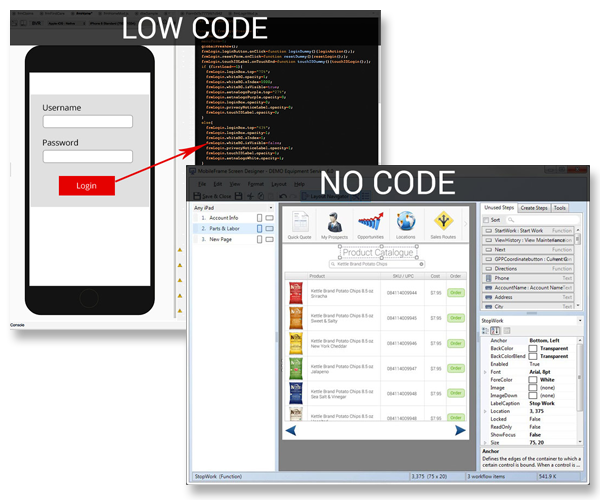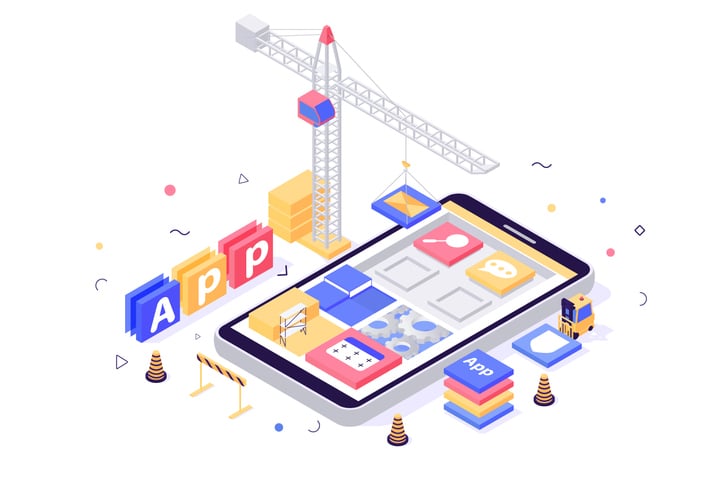Free Ideas For Choosing application development with Low-code platforms
Wiki Article
Benefits Of Low-Code Application Development For Developers Who Are Not Developers.
Due to a number of important factors, Low-Code Application Development is accessible to people who are not developers. These are referred to as "citizen designers."
Drag-and -Drop Builders. Low-code platforms come with drag-and -drop interfaces. This provides non-programmers with the ability to build applications using visuals, without having to write code. This makes the process of development more accessible to people with little or no technical knowledge.
WYSIWYG editor: The "What you see is what you get" editors allow users to create interfaces, workflows, and other features in a way which closely resembles the final result. They are simpler to understand and to use.
Simple workflow and logic
Visual Workflow Modeling: Users may develop business processes and apply logic using visual flowcharts and models that are easier to understand than traditional coding methods.
Low-code platforms typically come with pre-built logic components (e.g. the conditional loops, statements) that eliminate the need for complicated programming.
Templates and components that are reuseable:
Library of pre-built templates Numerous low-code platforms have a library of templates for common application types that allow non-programmers to begin with a solid foundation and customize as needed.
Reusable Widgets and Modules Users can make use of reused widgets. This makes it easier to create and reduces the need of extensive understanding.
Guided Development Tutorials and Guided Development:
Step-by step guides Platforms provide tutorials, on-screen tips, and a set of development steps to assist non-developers in creating applications.
Interactive Tutorials Interactive tutorials and hands-on ones allow users to learn through doing. They build confidence using the platform.
Integration with Existing Tools:
Integration seamless: Low-code platforms have been created to be able to seamlessly integrate with the existing business tools and systems (e.g. CRM, ERP) making it possible for non-developers to develop applications that fit into their workflows.
APIs, connectors: These tools facilitate integration by allowing developers who are not (or even end users) to connect their apps to external services.
Collaboration Features:
Team Collaboration Real-time collaboration, shared workspaces, and shared workspaces allow business analysts, non-developers, and other users to efficiently work alongside professional developers.
Access control based on Role: Non developers are able to be assigned certain roles and access levels. This allows them to participate in the development process without compromising security and performance.
Automated Testing and Debugging
Low-code platforms have tools for testing and debugging which are built into. They automatize this process so it is easy for non-developers to ensure that their apps run.
Error Highlighting: Whenever problems occur the platform flags the errors and suggests solutions by guiding non-developers through troubleshooting steps.
The capability of low-code apps to allow development for non-developers is its biggest advantage. Low-code platforms enable businesses to take part in the creation and maintenance of applications through the use of intuitive visual tools and a guided experience. This is a bridge between business and technical demands. View the best Low-code Platform for application development examples for more tips including rad application development, rad application development, azure sql, app dev platform, rad development, developing mobile apps, azure sql server, application modernisation, paas service, lowcode no code and more.

Benefits Of Low-Code Application Development In Terms Of Scalability, And Flexible
Low-code applications offer a variety of benefits, especially in terms scaleability. It is crucial to build applications that will expand with your company and be able to adapt as the business grows. Here are some of the key benefits.
Cloud-based deployment: A lot of low-code platforms are based. This allows applications to grow seamlessly in tandem with cloud infrastructure. Businesses can manage increased workloads without having to worry about server management.
Auto-Scaling Feature: Built-in features that automatically scale resources in order to meet demand can ensure consistent performance without manual input in peak hours.
Flexible Architecture:
Modular Application Design: The low-code platform encourages modular design of applications. Components can be independently developed, tested and increased in size. This is a fantastic method to improve flexibility. It can also be used to upgrade and expand components of an application without having to have the entire application affected.
Microservices Architecture: The Microservices architecture allows the creation of applications using an loosely coupled collection of services. This improves capacity and flexibility.
Customizable Options:
Extensibility. Low-code platform typically allows for scripting or programming that is custom. Developers can enhance the capabilities of the software beyond the capabilities it offers in the standard package. It allows developers to meet their specific business requirements without restrictions.
Third-Party Integrations: The capability of companies to integrate APIs and third-party apps, as well as add new features to their application when required, expands the capabilities of the application.
Agile Development and deployment
Continuous Delivery and Deployment : Low-code platforms can support agile methodologies which allow continuous integration, continuous delivery (CI/CD). This enables rapid deployment of updates and new features, assuring that the application can be updated quickly as a result of user feedback and market shifts.
Iterative Development: Thanks to the iterative nature, low-code applications can scale and improve gradually. This helps reduce the risks associated with major changes and permits greater control over expansion.
Resource Optimization
Effective resource management: Low code platforms optimize resources by offering instruments to monitor and manage the performance of applications. This helps ensure that resources are utilized efficiently and are scalable to meet actual needs.
Load Balancing: The integrated load balancing features distribute workloads evenly across servers, enhancing the capacity of applications to handle high traffic and ensure consistent performance.
Global Reach
Multi-Region Deployment: Low-code platforms generally support deployment across multiple geographical regions, which allows businesses to provide low-latency services to users around the world. This is especially important for applications which have an international user base.
Support for Localization. Built-in support to localize applications makes them easily adjusted to various languages, regional requirements and increases their flexibility across different markets.
Updates and maintenance:
Maintenance is made easier by the modularity and visual appeal of low-code apps makes maintenance simpler which allows quick updates and bugfixes to be applied without lengthy downtime.
Version Control: The integrated version control software helps manage changes and rolls backs. This means that updates can be easily installed and older versions can be restored if needed.
Cost Efficiency:
Lower Development Costs: By cutting down on the requirement for extensive code, low-code platforms cut down on development costs and make it feasible to scale apps without a proportional increase in development expenditure and effort.
Pay-As-You-Go Models - A lot of low-code applications have flexible pricing models, such as pay-as-you go that is based on actual usage, growth and financial flexibility.
Overall the scalability and flexibility advantages of low-code application development let businesses build robust, flexible, and scalable applications efficiently. These platforms allow for rapid adjustments to meet changing requirements, efficient resource use, and continual improvement, making sure that applications can grow and evolve with the business. Take a look at the recommended our site on Legacy application modernization with Low-code for website info including push notifications, multiplatform mobile app development, paas service, app dev platform, lowcode no code, azure sql, push alerts, app modernization, develop mobile application, cross platform app development and more.

Benefits Of Low-Code App Development With Respect To Limitations And Customization
Low-code applications offer an integrated approach that offers important advantages in terms of addressing limitations and allowing for customisation. These are the key advantages: Resolving the limitations
: .
Low-code development platforms are simpler to use because they provide ready-made components, templates, and various other tools. They also permit rapid deployment of even the most complex applications.
A lot of platforms offer guided workflows, which help developers navigate their way through the complex processes. They decrease the chances of errors and ensure the consistency.
Scalability Solutions
Scalability is built in: Low-code platforms often include features that allow for the development of scalable architecture. Applications can handle increased workloads with minimal changes.
Performance Monitoring: The tools that track and optimize performance can help make sure that applications run efficiently, even when they grow.
Security and Compliance
Low-code platforms come with security features such as security access control that is based on roles, encryption, and automated checks for compliance. These security features address commonly-asked security issues.
Platforms are regularly changing their security procedures and measures of conformity, which assures that applications remain safe against emerging threats.
Customization capabilities:
Extensibility:
Low-code platforms tend to integrate custom code, such as JavaScript or Python that allow developers to extend their functionality beyond the limitations of standard.
Developers can add extensions or modules to address specific business requirements.
APIs and Integration:
API Support - The extensive API support facilitates seamless integration with other systems and services and allows for complete customisation.
Third-Party Services : Low-code platforms often provides pre-built connections for popular services from third parties making integration and customizing easy.
Flexible Design for UI/UX
Customizable user interfaces: Developers can modify and design user interfaces in order to fulfill specific branding requirements as well as requirements for usability, resulting in the user with a customized experience.
Responsive Design The built-in capabilities of responsive design make sure that applications are able to be customized for different screens and devices.
Business Logic Customization
Visual Workflow Builders: These tools allow developers create complex processes with little or no coding. They are able to design business processes and workflows using visual.
Conditional Logic and Scripting: Platforms permit the inclusion of conditional logic as well as custom scripting to handle specific business rules and situations.
Data Management:
Custom Data Models: Developers can develop custom data models that fit specific needs of the application and ensure that data handling is custom-made to meet the needs of business.
Advanced Data Processor: The integration of advanced data-processing tools and capabilities allows for the customization of how data is analysed and used in the application.
How to balance customisation with limits:
Frameworks and Standards
Low-code platforms support the use of industry-standards and best practices, resulting in high-quality applications that are scalable and secure.
Governance Frameworks. Inbuilt frameworks for governance ensure that customizations will not compromise the security, integrity, or compliance of the application.
Feedback and iterative development:
Rapid Prototyping. The ability to speedily prototyping and testing customizations lets developers tweak the application based on the feedback of users. This helps to refine the application to better satisfy users' needs.
Continuous Improvement: Platforms that use low-code support continuous improvements that allow customization and enhancement when the requirements of business evolve.
User Empowerment
The empowerment of citizens-developers through low-code platforms increase the number of contributors capable of enhancing and customizing applications, by giving them the ability to modify their applications through intuitive user interfaces.
Training and Support: Many platforms offer a wealth of training and support to assist users with making efficient customizations without compromising the stability of the application or performance.
Low-code development is a powerful framework that permits a lot of customisation while addressing any issues. This allows businesses to create and maintain applications which are functional, tailored to meet their needs, and meet the highest standards of quality, security, and scaleability.
